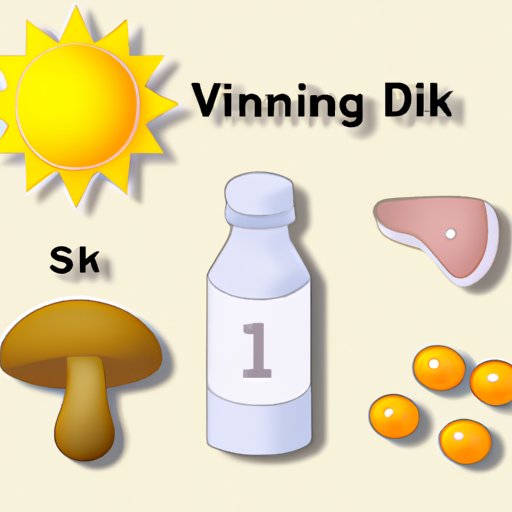
I. Introduction
Vitamin D is an essential nutrient that plays a crucial role in maintaining strong bones, regulating immune function, and supporting overall health. Unfortunately, many people are deficient in this vitamin, which can lead to a range of health problems. The good news is that there are many different ways to get more vitamin D, including spending time outdoors, consuming vitamin D-rich foods, taking supplements, and more.
II. Spend Time Outdoors
The most natural way to get vitamin D is to spend time in the sun. When ultraviolet B (UVB) rays from the sun hit the skin, they trigger the body’s natural production of vitamin D. However, it’s important to be mindful of the risks of too much exposure to the sun, such as sunburn and skin cancer. As a general guideline, aim to get 10-30 minutes of sun exposure without sunscreen several times a week. This can be done through activities like walking, gardening, or playing outdoor sports.
III. Consume Vitamin D-Rich Foods
In addition to sunlight, getting more vitamin D can also be accomplished through diet. Some of the best food sources of vitamin D include fatty fish like salmon and tuna, egg yolks, and beef liver. Other foods that are fortified with vitamin D, such as milk, orange juice, and cereals, can also help increase intake. Incorporating these foods into a healthy diet is a great way to boost vitamin D levels.
Here are a few recipe ideas to get started:
- Salmon patties with a side of sautéed spinach and mushrooms
- Egg and cheese breakfast burrito with salsa
- Beef liver pate spread on whole-grain crackers
- Berry smoothie made with fortified almond milk and Greek yogurt
IV. Take Supplements
For those who have trouble getting enough vitamin D through sunlight and food alone, supplements can be a good option. Vitamin D supplements come in different forms like pills, drops, and gummies, and can be found over the counter at most stores, as well as through healthcare providers. It’s important to talk to a healthcare provider before taking supplements, especially if you have certain health conditions or are taking other medications. When taking supplements, it’s important to follow dosing guidelines carefully and avoid taking more than recommended.
V. Mushroom
While mushrooms aren’t typically thought of as a vitamin D source, certain types like shiitake and portobello can actually help boost levels. This is because mushrooms produce vitamin D when exposed to sunlight, just like human skin. Incorporating mushrooms into recipes is an easy way to add a bit of vitamin D to your diet. Here are some recipes to try:
- Roasted portobello mushroom caps stuffed with spinach and feta
- Shiitake mushroom risotto with Parmesan cheese
- Mushroom and lentil shepherd’s pie topped with mashed potatoes
- Mushroom and sausage breakfast hash with diced potatoes and onions
VI. UV Lamps
In some cases, UV lamps under medical supervision may be used to help the body produce vitamin D when sunlight and diet are not enough. However, it’s important to proceed with caution when considering this option, as overexposure to UV radiation can have serious health consequences. Always consult with a healthcare provider before using a UV lamp for vitamin D production.
VII. Soy Milk
For people who don’t consume dairy products, fortified soy milk can be an excellent way to get vitamin D. Other plant-based milk alternatives like almond or oat milk may also be fortified with vitamin D. Here’s a recipe that uses soy milk as a base:
- Homemade tofu scramble made with soy milk, diced vegetables, and nutritional yeast
VIII. Cod Liver Oil
Cod liver oil is another reliable source of vitamin D, as well as omega-3 fatty acids which are great for heart health. It’s important to note that cod liver oil is a dietary supplement and should be used in moderation. While it can provide numerous benefits, it’s possible to take too much, which can lead to health complications. Here are some easy ways to incorporate cod liver oil into your diet:
- Add a teaspoon of cod liver oil to a morning smoothie
- Take cod liver oil supplements alongside a meal containing healthy fats, like avocado and nuts
- Drizzle cod liver oil on top of roasted vegetables for added flavor and health benefits
IX. Conclusion
Getting enough vitamin D is essential for overall health and wellness, but it can be tricky for many people. Thankfully, there are many different strategies for increasing vitamin D levels, from spending time outdoors to consuming vitamin D-rich foods and supplements. By incorporating a variety of these tips into a healthy lifestyle, it’s easy to ensure that your body is getting the vitamin D it needs to thrive.





